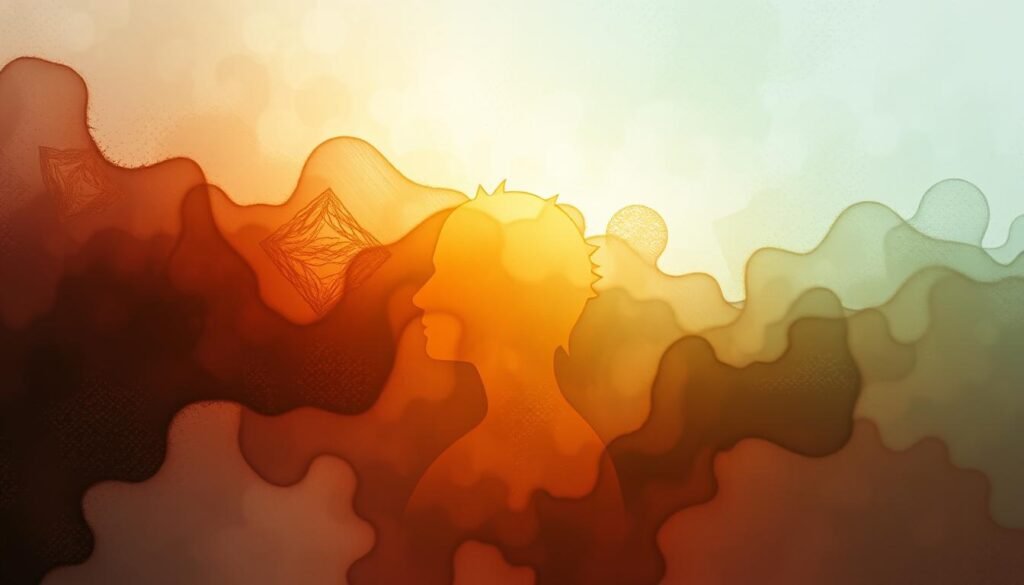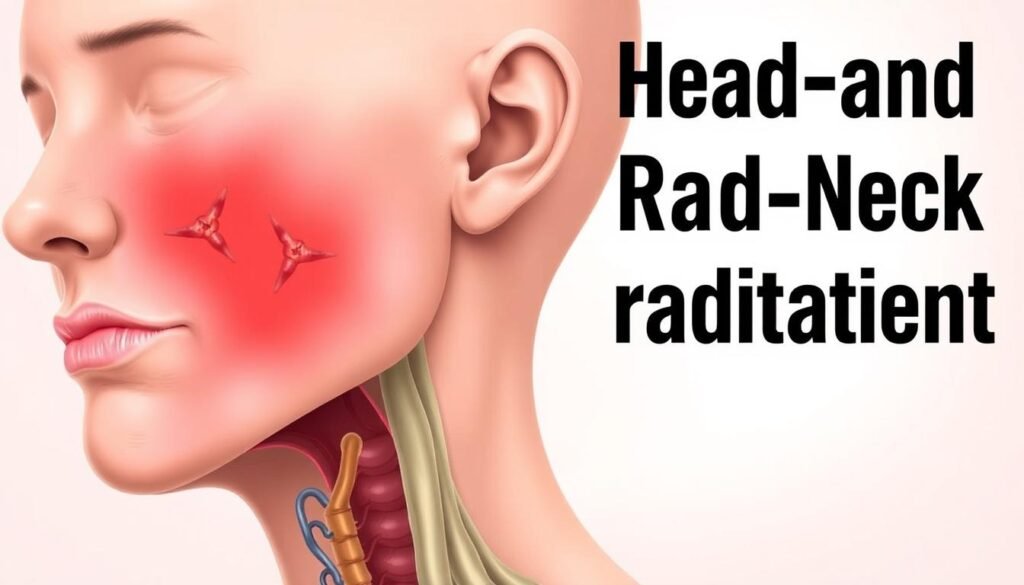Did you know more than half of all patients getting radiation for lung cancer feel major side effects? They report problems like hard swallowing or feeling more out of breath. Knowing these possible side effects is key for anyone getting treatment for non-small cell lung cancer (NSCLC). How you react to radiation can be very different from someone else. It depends on the radiation type, the dose, and where you’re treated. While some may have mild effects, others face tougher challenges.
Typically, side effects fade a few months after treatment ends. But some symptoms might stick around, depending on how well healthy cells recover. Talking openly with your healthcare team is crucial. It helps manage these side effects well. This ensures you get the support you need during your treatment journey.
Key Takeaways
- Side effects of radiation treatment can affect various aspects of daily living.
- About 50% of patients report significant issues like swallowing difficulties.
- Open dialogue with healthcare providers enhances symptom management.
- Most side effects are temporary, but some can linger longer.
- Radiation therapy for lung cancer often involves multiple treatment sessions per week.
Understanding Radiation Therapy
Radiation therapy is key in fighting cancer. It uses high-energy waves to attack cancer cells. This is very important for those with non-small cell lung cancer (NSCLC). They might get this treatment alone or with surgery and chemo. The goal is to target tumors but not harm healthy tissue.
Three-dimensional conformal radiation therapy shapes beams to the tumor’s size. This limits harm to healthy areas. Intensity-modulated radiation therapy takes it further. It uses many small beams with adjusted strengths to protect healthy tissue.
Treatment is usually given daily for five days a week, over many weeks. This method makes the therapy more effective and reduces side effects. For patients with small tumors or those who can’t have surgery, stereotactic body radiation therapy is a choice. This approach gives strong doses of radiation in a short period.
Brachytherapy puts radiation right in the airway to shrink tumors. How this is done depends on the tumor’s location next to healthy tissue. It determines the dose and frequency needed.
Alongside radiation, targeted therapy and precision medicine are changing NSCLC care. With new tests, doctors find specific changes in the tumors. For instance, a small percent of patients might have an ALK gene change. Others might have mutations in the KRAS gene. These insights lead to personalized treatments that mix radiation with new drugs. This approach is improving how well treatments work.
Common Side Effects of Radiation Treatment
Patients facing non-small cell lung cancer often deal with side effects from radiation. Knowing these effects helps them get ready for what’s coming. Learning to handle these issues makes the treatment journey smoother.
Fatigue
Fatigue is a big side effect of radiation. It feels like deep tiredness that rest doesn’t fix. This tiredness gets worse during treatment and can last a while after finishing.
It’s key to know about this and rest when needed. This helps keep energy levels in check.
Skin Reactions
Skin reactions are common, too. They include redness, dryness, and peeling skin. It’s important to care for your skin softly during this time.
Using gentle soaps and lotions helps. It’s crucial to keep an eye on your skin to prevent worse problems.
Hair Loss
Hair loss is also a typical side effect. It usually starts two to three weeks after the first treatment. Often, hair grows back after treatment, but it might be thinner or different.

| Common Side Effects | Description | Management Tips |
|---|---|---|
| Fatigue | Overwhelming tiredness, worsening with treatment. | Rest often, plan activities carefully. |
| Skin Reactions | Redness, irritation, and peeling in treated areas. | Use mild soaps and moisturizers. |
| Hair Loss | Loss of hair in the treatment zone. | Expect regrowth, though it may be different. |
Understanding these side effects is empowering for patients. For more details on managing these effects and on radiation therapy, visit Cancer.org.
Early and Late Side Effects
Radiation therapy is key for many cancer patients. It helps to know the different types of side effects. These include early and late side effects, showing up at various times, affecting life quality.
Short-Term Effects
Early side effects appear during or soon after treatment. These can range from mild to moderate and often go away in weeks. Some common ones are:
- Fatigue: A deep tiredness that rest doesn’t fix.
- Skin reactions: Skin redness, irritation, or peeling in the treated spot.
- Nausea: Feeling sick, especially after treating the abdomen.
- Changes in appetite: Different desire for food or tastes.
Long-Term Effects
Late side effects surface months or years post-treatment. These can impact body systems long-term. A few possible late side effects are:
- Organ damage: Harm to organs close to the treatment area, like lungs or heart.
- Secondary cancers: A higher chance of new cancers in the future.
- Persistent changes in skin: Lasting skin texture or color changes.
- Fertility issues: Impact on reproductive organs.
Knowing about these side effects is crucial for those getting radiation therapy. Talking with healthcare providers is key to managing symptoms and bettering life quality.

| Type of Side Effect | Examples | Duration |
|---|---|---|
| Early Side Effects | Fatigue, Skin reactions, Nausea | Weeks |
| Late Side Effects | Organ damage, Secondary cancers, Fertility issues | Months to Years |
Specific Side Effects by Treatment Area
Knowing the side effects of radiation therapy is important for patients. Each body part treated with radiation may have different reactions. It is essential for patients to understand these to manage and prepare better.
Head and Neck Radiation
Common side effects for head and neck radiation include:
- Mouth sores and ulcers, which can lead to discomfort during eating
- Taste changes, affecting the enjoyment of food
- Swallowing difficulties, requiring dietary adjustments and interventions
- Dry mouth, increasing the risk of dental problems
Chest Radiation
Chest radiation may bring specific side effects impacting life quality. These are:
- Respiratory issues, such as shortness of breath or cough
- Skin changes in the treated area, including redness or irritation
- Fatigue, which can diminish daily activities and social interactions
Brain Radiation
Brain radiation has unique side effects patients may experience. This includes:
- Headaches, which vary in intensity
- Memory problems, affecting cognitive function and daily tasks
- Hair loss, particularly in the radiation area

| Treatment Area | Common Side Effects |
|---|---|
| Head and Neck | Mouth sores, taste changes, swallowing issues, dry mouth |
| Chest | Respiratory difficulties, skin changes, fatigue |
| Brain | Headaches, memory problems, hair loss |
Managing Side Effects
Good patient care during radiation therapy focuses on managing side effects early on. It’s vital for patients to work with their healthcare teams to tackle any new symptoms fast. Dealing with fatigue is one major challenge that patients face, affecting their daily lives. Changes in medicine, diet, or adding counseling can make a big difference in side effect relief.
To help manage symptoms, patients might:
- Take prescribed pain medicine to ease pain.
- Use inhalers or respiratory meds to help with breathing.
- Apply moisturizers to deal with dry skin.
- Prepare for possible hair loss.
- Keep clean to avoid infections.
- Work with a nutritionist to eat right and avoid losing weight.
Staying hydrated is also key. Not drinking enough water worsens side effects, especially with treatments like chemo. Drinking more fluids helps with symptoms like diarrhea and tiredness.
Working well with your healthcare team is very important. Keeping open communication helps make treatment changes quickly, so patients get the best supportive care. Looking into other treatments, as mentioned in this resource, can improve well-being, too.
Radioprotective Drugs for Reducing Side Effects
Almost half of all cancer patients will need radiation therapy. Sadly, this essential treatment can cause side effects like skin issues, hair loss, and taste changes. Radioprotective drugs are being looked at to help with these problems.
Amifostine stands out among these drugs. It helps lower side effects by protecting healthy cells from radiation damage. This is especially important for patients treated for cancers in the head and neck area. For them, saving the surrounding healthy tissue is key to keeping a good quality of life. Amifostine protects cells in several ways, including cleaning up harmful free radicals and helping fix DNA.
However, giving patients drugs like amifostine must be done with care. They have their own side effects. Patients and their doctors need to talk about the good and the bad sides of these drugs.
Researchers continue to explore better ways to make and use these drugs. They are making changes to natural compounds to boost their protective power. This work could make these drugs more useful in treating patients. As science moves forward, knowing about these drugs helps patients choose wisely in their care plans. Read more about this research here.
| Type of Radioprotective Agent | Mechanism of Action | Example |
|---|---|---|
| Synthetic Radioprotectors | Scavenging of free radicals | Amifostine |
| Natural Compounds | Promoting DNA repair processes | Polyphenols |
| Antioxidants | Enhancing antioxidant defenses | Curcumin |
How Targeted Therapy for NSCLC Influences Radiation Treatment
Cancer treatment has gotten better, especially how targeted therapy for NSCLC works with radiation. Now, we use precision medicine, like looking at genes, to create better treatment plans.
Targeted therapies attack specific changes in cancer cells. For example, EGFR and ALK inhibitors go after the parts that make NSCLC grow. These treatments help radiation work better, causing fewer side effects and improving chances for patients.
Studies show that mixing targeted therapy with radiation helps control the disease better and may make patients live longer. Doctors can use information about the tumor to adjust radiation. This makes treatment more effective.
This teamwork of targeted drugs and radiation is leading us to smarter ways to fight NSCLC. Ongoing research keeps improving how we treat cancer, moving us from a one-size-fits-all method to care that’s more personal. For more about how these work together, check out recent studies and resources here.
To sum up, new cancer treatments are getting better thanks to targeted therapies. With precision medicine, doctors can make radiation plans that fit each NSCLC patient’s genetic makeup.
Importance of Communication with Your Care Team
Talking with your care team is key during radiation treatment. Patients need to voice concerns, symptoms, and treatment preferences. Having open talks creates a team effort, where plans can change for the better.
Reporting Symptoms
Quickly telling your doctors about symptoms helps them understand your health better. Being active in this helps spot side effects early. This leads to quick changes that can make treatment easier.
Adjusting Treatment Plans
Health changes may need treatment plans to change. Regular talks about health allow for better results and give patients control. Through clear talks, decisions are made together, fitting the patient’s life and wishes.
A study shows a lack of talk about end-of-life care among advanced-stage cancer patients. Only 38% had this crucial conversation. Patients who do talk about it choose less intense treatments. This shows why sharing care preferences matters.
| Patient Engagement | Outcomes |
|---|---|
| Engaged in symptom reporting | Timely treatment adjustments |
| Discussed care preferences | Less aggressive treatment |
| Participated in decision making | Higher quality of life |
| Maintained open dialogue | Improved satisfaction |
Strong communication with your care team is very important for the best treatment results. Patients should take part in discussing their care. This way, they can report symptoms and help shape their treatment. Doing this improves care and leads to better health during radiation therapy.
Conclusion
It’s vital to understand radiation treatment when dealing with cancer. Each year, 1.6 million people die from lung cancer. Learning about this can help patients handle their treatments better.
Knowing how to manage side effects makes it easier to talk with doctors. This means patients can get care that fits their needs better. It helps make their quality of life better during a tough time.
There have been big steps forward in treating non-small cell lung cancer. Targeted therapy is one of these advances. This gives patients better results. It also causes fewer side effects.
Doctors now know more about what causes this kind of cancer. They use new ways to treat it. This lets them help patients more effectively.
Talking openly and understanding treatment can make patients feel more confident. When patients know more, they can speak up for what they need. This makes sure they get the right care during their cancer treatment.